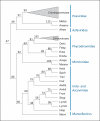Origin and evolution of eukaryotic large nucleo-cytoplasmic DNA viruses
- PMID: 20551680
- PMCID: PMC2895762
- DOI: 10.1159/000312913
Origin and evolution of eukaryotic large nucleo-cytoplasmic DNA viruses
Abstract
Background/aims: The nucleo-cytoplasmic large DNA viruses (NCLDV) constitute an apparently monophyletic group that consists of 6 families of viruses infecting a broad variety of eukaryotes. A comprehensive genome comparison and maximum-likelihood reconstruction of NCLDV evolution reveal a set of approximately 50 conserved genes that can be tentatively mapped to the genome of the common ancestor of this class of eukaryotic viruses. We address the origins and evolution of NCLDV.
Results: Phylogenetic analysis indicates that some of the major clades of NCLDV infect diverse animals and protists, suggestive of early radiation of the NCLDV, possibly concomitant with eukaryogenesis. The core NCLDV genes seem to have originated from different sources including homologous genes of bacteriophages, bacteria and eukaryotes. These observations are compatible with a scenario of the origin of the NCLDV at an early stage of the evolution of eukaryotes through extensive mixing of genes from widely different genomes.
Conclusions: The common ancestor of the NCLDV probably evolved from a bacteriophage as a result of recruitment of numerous eukaryotic and some bacterial genes, and concomitant loss of the majority of phage genes except for a small core of genes coding for proteins essential for virus genome replication and virion formation.
Copyright 2010 S. Karger AG, Basel.
Figures



Similar articles
-
Hidden evolutionary complexity of Nucleo-Cytoplasmic Large DNA viruses of eukaryotes.Virol J. 2012 Aug 14;9:161. doi: 10.1186/1743-422X-9-161. Virol J. 2012. PMID: 22891861 Free PMC article.
-
Eukaryotic large nucleo-cytoplasmic DNA viruses: clusters of orthologous genes and reconstruction of viral genome evolution.Virol J. 2009 Dec 17;6:223. doi: 10.1186/1743-422X-6-223. Virol J. 2009. PMID: 20017929 Free PMC article.
-
Phylogenetic evidence for extensive lateral acquisition of cellular genes by Nucleocytoplasmic large DNA viruses.BMC Evol Biol. 2008 Nov 26;8:320. doi: 10.1186/1471-2148-8-320. BMC Evol Biol. 2008. PMID: 19036122 Free PMC article.
-
Evolutionary genomics of nucleo-cytoplasmic large DNA viruses.Virus Res. 2006 Apr;117(1):156-84. doi: 10.1016/j.virusres.2006.01.009. Epub 2006 Feb 21. Virus Res. 2006. PMID: 16494962 Review.
-
Evolution of the Large Nucleocytoplasmic DNA Viruses of Eukaryotes and Convergent Origins of Viral Gigantism.Adv Virus Res. 2019;103:167-202. doi: 10.1016/bs.aivir.2018.09.002. Epub 2018 Nov 10. Adv Virus Res. 2019. PMID: 30635076 Review.
Cited by
-
Mimiviridae: clusters of orthologous genes, reconstruction of gene repertoire evolution and proposed expansion of the giant virus family.Virol J. 2013 Apr 4;10:106. doi: 10.1186/1743-422X-10-106. Virol J. 2013. PMID: 23557328 Free PMC article.
-
Comparative Genomics of Amphibian-like Ranaviruses, Nucleocytoplasmic Large DNA Viruses of Poikilotherms.Evol Bioinform Online. 2016 Oct 25;11(Suppl 2):71-82. doi: 10.4137/EBO.S33490. eCollection 2015. Evol Bioinform Online. 2016. PMID: 27812275 Free PMC article.
-
Giant Virus Infection Signatures Are Modulated by Euphotic Zone Depth Strata and Iron Regimes of the Subantarctic Southern Ocean.mSystems. 2023 Apr 27;8(2):e0126022. doi: 10.1128/msystems.01260-22. Epub 2023 Feb 16. mSystems. 2023. PMID: 36794943 Free PMC article.
-
Virus diversity and interactions with hosts in deep-sea hydrothermal vents.Microbiome. 2022 Dec 24;10(1):235. doi: 10.1186/s40168-022-01441-6. Microbiome. 2022. PMID: 36566239 Free PMC article.
-
Another really, really big virus.Viruses. 2011 Jan;3(1):32-46. doi: 10.3390/v3010032. Epub 2011 Jan 18. Viruses. 2011. PMID: 21994725 Free PMC article.
References
-
- Raoult D, Forterre P. Redefining viruses: lessons from Mimivirus. Nat Rev Microbiol. 2008;6:315–319. - PubMed
-
- Forterre P. The origin of viruses and their possible roles in major evolutionary transitions. Virus Res. 2006;117:5–16. - PubMed
-
- Iyer LM, Balaji S, Koonin EV, Aravind L. Evolutionary genomics of nucleo-cytoplasmic large DNA viruses. Virus Res. 2006;117:156–184. - PubMed
Publication types
MeSH terms
Grants and funding
LinkOut - more resources
Full Text Sources

